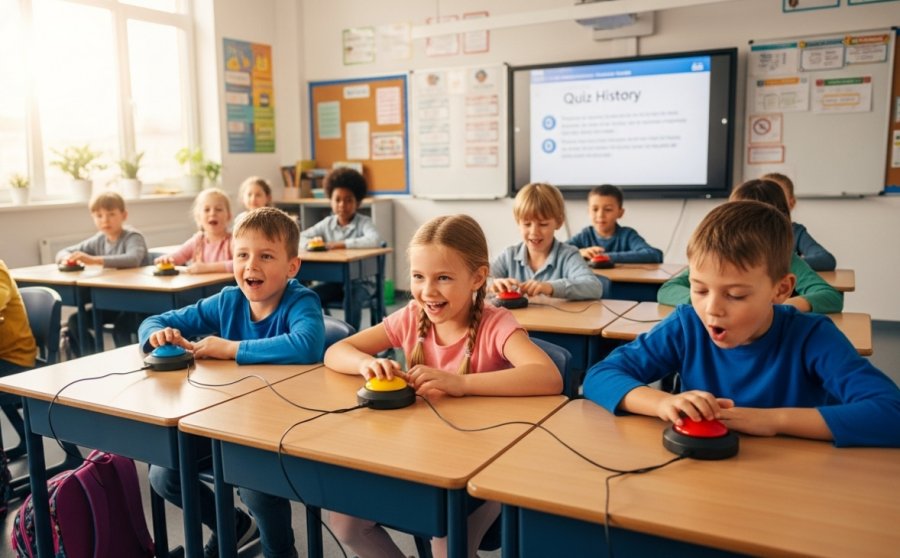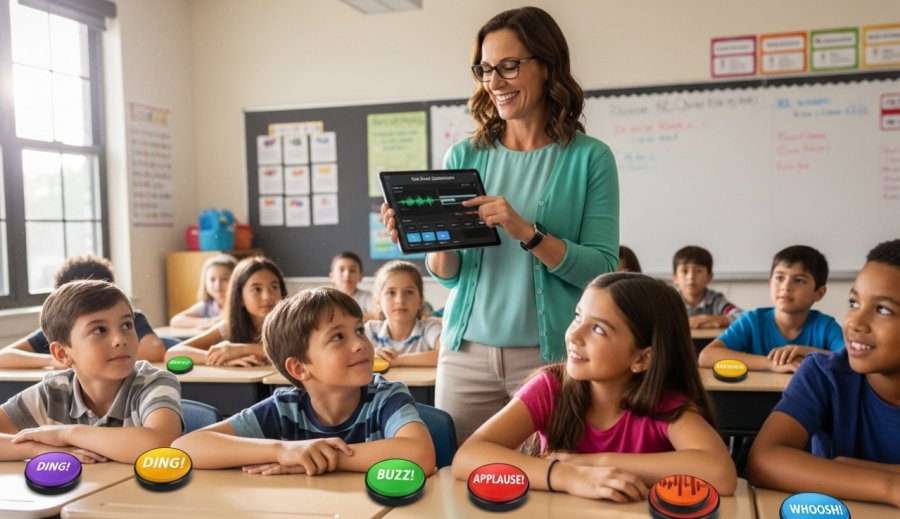How Sound Buttons Can Turn Quizzes Into Fun Classroom Games

Classroom quizzes often feel like chores to children, but they don’t have to. With the right touch of excitement, they can transform into something children actually look forward to. That’s where sound buttons come in.
Imagine laughter, quick reactions, and playful competition filling the room during review time. Instead of silence and nervous faces, you’ll hear cheerful buzzes and giggles. Used wisely, sound buttons can shift a traditional quiz into an engaging classroom game that sparks curiosity and joy.
How Do Sound Buttons Change the Mood of a Quiz?
Children often associate quizzes with pressure, but sound buttons flip that expectation. A bright, playful sound makes answering feel less like a test and more like a challenge in a game show. That shift reduces anxiety and increases participation.
Even shy students find it easier to join in when the activity feels fun. The sound itself becomes a signal of celebration, not stress. And when learning feels like play, kids remember the lessons better, too.
What Makes Sound Buttons Effective in Classrooms?
Sound buttons aren’t just toys. They tap into psychology. The brain connects sounds with emotions, and children instinctively respond to playful cues. When students buzz in, they feel part of a lively, shared experience instead of being isolated under pressure.
Teachers have also noticed improved focus. Children listen more closely, hoping for their chance to buzz. That’s why many educators turn to Sound Buttons Lab, where you can customize sound effects to match your students’ energy and spark sharper attention. The playful anticipation transforms routine activities into moments of excitement, reinforcing participation through sound-driven engagement.
Why Should Teachers Use Sound Buttons for Group Learning?
Group activities often leave some children overshadowed. But with sound buttons, every student has a chance to step forward. The anticipation of buzzing in energizes even quieter voices, creating a more balanced classroom dynamic.
This method also builds teamwork. When students split into groups, each team member cheers for the other’s chance to press the button. That sense of belonging strengthens class spirit and reduces the fear of mistakes.
When Do Sound Buttons Work Best in Teaching?
Timing matters. Not every lesson calls for extra excitement, but quizzes, reviews, and brainstorming sessions are ideal moments. Adding sound buttons after teaching a tough topic makes recall practice feel less rigid.
For younger kids, they’re best used during shorter, high-energy activities. Older children respond well when used in review games before a test. The key is strategic use, frequent enough to boost engagement, but spaced out to preserve novelty and effectiveness.
How Can Teachers Set Up Sound Button Quizzes?
To make sound button quizzes truly effective, you’ll want a structured approach. It starts with preparing rules and setting expectations. From there, you can adjust the setup for age, lesson goals, and classroom size. To run sound button quizzes smoothly, focus on these setup essentials that balance structure, inclusivity, and sensory awareness:
Establishing Clear Rules
Children thrive with structure. Before the first buzz, explain how the game works: who gets to press, how points are counted, and what happens if two buttons buzz at once. Clear rules keep fun from turning into chaos.
Choosing Sounds Wisely
Not every sound works in a classroom. Pick ones that are cheerful but not distracting, like chimes or short buzzes. Loud, harsh noises can overstimulate children, especially those sensitive to sensory input, so softer sounds keep the mood playful.
Keeping It Fair
Fairness builds trust. Rotate who gets to press the button and make sure every student has an equal opportunity. This avoids letting only the fastest or most confident kids dominate the activity, giving all learners a chance to shine.
What Common Myths Exist About Sound Buttons?
A frequent misconception is that sound buttons make children rowdy and unfocused. In reality, when paired with structure, they encourage discipline. Kids pay attention because they want their chance to buzz, not because they’re being policed.
Another myth is that sound buttons are “just for fun” and don’t contribute to real learning. That misses the point. Play activates memory pathways. When children laugh and engage actively, the lesson sticks longer than it would through rote memorization alone.

Where Can Teachers Add Extra Creativity With Sound Buttons?
Beyond quizzes, sound buttons can enrich activities like storytelling, vocabulary games, or even behavior rewards. For example, a story session could include a special button sound every time a keyword appears, keeping attention sharp and playful.
In language learning, assigning sounds to different words turns repetition into a game. Even classroom management benefits: a gentle chime can signal transitions more smoothly than raising your voice. Sound buttons open the door to endless creative strategies.
Frequently Asked Questions
How do I introduce sound buttons without overwhelming students?
Start small. Use them in one short game or quiz, and let children get comfortable with the novelty. Once they understand the routine, gradually expand their use.
What if students argue over who gets to press the button?
Set up a rotation system or let the team nominate a different student each round. Clear structure ensures fairness and keeps excitement from turning into frustration.
Are sound buttons suitable for children with sensory sensitivities?
Yes, but choose gentle, pleasant sounds and test them first. Allow those who feel uncomfortable to participate in other roles, like scorekeeper or reader, so no one feels excluded.
Can sound buttons be used in virtual classrooms?
Absolutely. Many digital tools replicate sound buttons, letting children buzz in from home. The principle remains the same: sounds make quizzes feel lively and interactive, no matter the setting.





